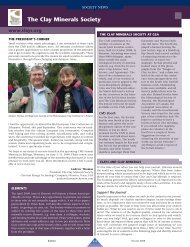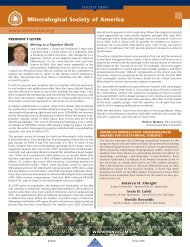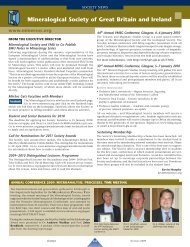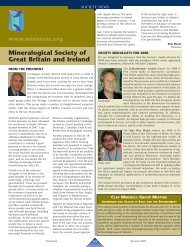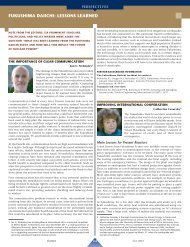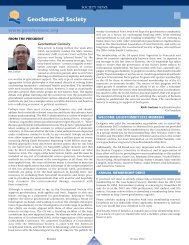Editorial - Elements Magazine
Editorial - Elements Magazine
Editorial - Elements Magazine
Create successful ePaper yourself
Turn your PDF publications into a flip-book with our unique Google optimized e-Paper software.
EDITORIAL<br />
PRINCIPAL EDITORS<br />
E. BRUCE WATSON, Rensselaer Polytechnic<br />
Institute, USA (watsoe@rpi.edu)<br />
SUSAN L.S. STIPP, Københavns Universitet,<br />
Denmark (stipp@nano.ku.dk)<br />
DAVID J. VAUGHAN, The University of Manchester<br />
(david.vaughan@manchester.ac.uk)<br />
ADVISORY BOARD<br />
ROBERTO COMPAGNONI, Università degli Studi<br />
di Torino, Italy<br />
RANDALL T. CYGAN, Sandia National<br />
Laboratories, USA<br />
JAMES I. DREVER, University of Wyoming, USA<br />
ADRIAN FINCH, University of St Andrews, UK<br />
JOHN E. GRAY, U.S. Geological Survey, USA<br />
JANUSZ JANECZEK, University of Silesia, Poland<br />
HANS KEPPLER, Bayerisches Geoinstitut,<br />
Germany<br />
DAVID R. LENTZ, University of New Brunswick,<br />
Canada<br />
MAGGI LOUBSER, University of Pretoria,<br />
South Africa<br />
DOUGLAS K. MCCARTY, Chevron Texaco, USA<br />
KLAUS MEZGER, Universität Münster, Germany<br />
JAMES E. MUNGALL, University of Toronto,<br />
Canada<br />
TAKASHI MURAKAMI, University of Tokyo, Japan<br />
ERIC H. OELKERS, LMTG/CNRS, France<br />
HUGH O’NEILL, Australian National University,<br />
Australia<br />
XAVIER QUEROL, Spanish Research Council,<br />
Spain<br />
NANCY L. ROSS, Virginia Tech, USA<br />
EVERETT SHOCK, Arizona State University, USA<br />
OLIVIER VIDAL, Université J. Fourier, France<br />
EXECUTIVE COMMITTEE<br />
ROBERT BOWELL, Association of Applied<br />
Geochemists<br />
GIUSEPPE CRUCIANI, Società Italiana di<br />
Mineralogia e Petrologia<br />
RODNEY C. EWING, Chair<br />
RAY E. FERRELL, The Clay Minerals Society<br />
DAVID A. FOWLE, Mineralogical Association<br />
of Canada<br />
JOHN M. HUGHES, Mineralogical Society<br />
of America<br />
CATHERINE MÉVEL, Société Française<br />
de Minéralogie et de Cristallographie<br />
MAREK MICHALIK, Mineralogical Society of Poland<br />
MANUEL PRIETO, Sociedad Española de<br />
Mineralogía<br />
CLEMENS REIMANN, International Association<br />
of GeoChemistry<br />
NEIL C. STURCHIO, Geochemical Society<br />
PETER TRELOAR, Mineralogical Society<br />
of Great Britain and Ireland<br />
FRIEDHELM VON BLANCKENBURG,<br />
Deutsche Mineralogische Gesellschaft<br />
MICHAEL J. WALTER, European Association<br />
for Geochemistry<br />
MICHAEL WIEDENBECK, International<br />
Association of Geoanalysts<br />
MANAGING EDITOR<br />
PIERRETTE TREMBLAY<br />
tremblpi@ete.inrs.ca<br />
EDITORIAL OFFICE<br />
490, rue de la Couronne<br />
Québec (Québec) G1K 9A9 Canada<br />
Tel.: 418-654-2606<br />
Fax: 418-654-2525<br />
Layout: POULIOT GUAY GRAPHISTES<br />
Copy editor: THOMAS CLARK<br />
Proofreaders: THOMAS CLARK,<br />
DOLORES DURANT<br />
Printer: CARACTÉRA<br />
The opinions expressed in this magazine are<br />
those of the authors and do not necessarily<br />
reflect the views of the publishers.<br />
www.elementsmagazine.org<br />
QUIET REVOLUTION IN<br />
THE GEOCHEMICAL SCIENCES<br />
E. Bruce Watson<br />
I am writing these words on my way home from<br />
the 2008 Goldschmidt Conference in Vancouver,<br />
so it’s possible that I’m writing in a state of overstimulation:<br />
by any measure it was an extraordinary<br />
meeting that lived up to its promise to cover<br />
science “from SEA to SKY.”<br />
Much of the credit for the success of this year’s<br />
Goldschmidt Conference should go to the organizers<br />
and sponsors of the meeting, and I hope all<br />
of you will join me in congratulating the program<br />
committee and chairs Rick Carlson, Barbara Sherwood<br />
Lollar, and Dominique Weis. Still, I think<br />
there is more going on in the field of geochemistry<br />
than a scenic venue and<br />
thoughtful planning: the conference<br />
took place within the<br />
context of far-reaching, fundamental<br />
developments in the<br />
geochemical sciences. These<br />
developments have been apparent<br />
at many recent meetings,<br />
and I think they will continue<br />
to be prominent for the foreseeable<br />
future. At the risk of<br />
being overly dramatic, I believe<br />
we are in the midst of a quiet<br />
revolution in the geochemical<br />
sciences.<br />
At the root of this revolution is the unprecedented<br />
proliferation of technology that not only<br />
drives the science we’re doing but also is driven<br />
by it. One side of the equation is the breathtaking<br />
advancement in our ability to measure the isotopic<br />
and elemental composition and structure of<br />
Earth materials—solid, fluids, vapors, and organic<br />
materials—at scales ranging vastly through time<br />
and space, down even to the nanometer and<br />
molecular level. Some of my colleagues in analytical<br />
geochemistry assure me that thirty years ago<br />
we were able to measure certain isotope ratios and<br />
trace-element abundances in many systems with<br />
precision and accuracy equalling today’s capability.<br />
While this observation is certainly true, it<br />
misses the key point that today’s analyst needn’t<br />
be as experienced nor as committed to specific<br />
types of measurements in order to do them well.<br />
For better or for worse, we have entered a period<br />
At the root of this<br />
revolution is the<br />
unprecedented<br />
proliferation of<br />
technology that not<br />
only drives the science<br />
we’re doing but also<br />
is driven by it.<br />
of exploration in analytical geochemistry in<br />
which discoveries are limited more by ideas than<br />
by analytical capabilities. The proliferation of<br />
technology has stimulated exploration of isotope<br />
ratios (e.g. non-traditional stable isotopes) that<br />
would never have been attempted even a decade<br />
ago: this, in turn, has engendered an adventuresome<br />
attitude among scientists that few laboratories<br />
could have justified previously. Some might<br />
argue that technology has put powerful tools in<br />
the hands of babes, but I think the evidence is<br />
that, on balance, this is a good thing.<br />
Can we, as practicing scientists, be proud of this<br />
revolution, and can we really claim it as our own<br />
“grass roots” movement? Or, are we simply<br />
exploiting the technology made available to us by<br />
the innovative engineers employed by (for example)<br />
the gracious sponsors of our meetings and<br />
publications? Here, I think we are on a two-way<br />
street. I was told recently by a sales representative<br />
of a major instrument manufacturer that, of all<br />
the communities in which his instruments are<br />
marketed (physics, chemistry, materials science,<br />
biology), it is by far the geoscientists who are the<br />
most vocal in pushing for new capabilities. So<br />
maybe we are not simply the fortunate beneficiaries<br />
of corporate invention and entrepreneurship,<br />
but rather integral partners in the science/technology<br />
symbiosis. Our ambition and<br />
ideas drive the development of<br />
commercial instruments, and<br />
these in turn energize and<br />
diversify our science.<br />
It is especially interesting to me<br />
that we seem to be at a juncture<br />
where our ability to measure<br />
chemical “signatures” has far<br />
outstripped our ability to interpret<br />
those signatures in a<br />
unique way. On fronts ranging<br />
from the origin of life to magmatic<br />
evolution, for example,<br />
intriguing inferences are being<br />
drawn from small apparent<br />
anomalies in isotope ratios; however, in none of<br />
these areas have we comprehensively evaluated<br />
the mechanisms that could produce these anomalies.<br />
This makes the present time especially exciting<br />
and challenging for experimentalists like<br />
myself, whose “job” it is to characterize the<br />
behavior of elements and isotopes under controlled<br />
laboratory conditions and attempt to<br />
extrapolate findings to natural systems. In the<br />
distant future—if we are lucky and tireless—perhaps<br />
we will complete the interpretational framework<br />
for signatures, anomalies, and structures<br />
documented in natural systems. In the meantime,<br />
the profusion of new analytical results from natural<br />
samples provides experimentalists with<br />
ample motivation and inspiration, and in that<br />
respect makes us part of the revolution.<br />
Cont’d on page 220<br />
E L E M E N T S 219<br />
AUGUST 2008
FROM THE EDITORS<br />
THIS ISSUE<br />
Guest editors James Brenan and James Mungall<br />
have brought together a cast of international<br />
authors to give you an up-to-date overview of<br />
the economic, scientific, and environmental<br />
significance of the platinum-group elements.<br />
PAST PRINCIPAL EDITOR HONORED<br />
Michael F. Hochella Jr. was honored during the<br />
recent Goldschmidt Conference for his distinguished<br />
service to the Geochemical Society, as<br />
vice president, president, and past president<br />
(1998–2003), as co-organizer of the 2001 V.M.<br />
Goldschmidt Conference, and as “former Principal<br />
Editor of the extraordinarily successful<br />
<strong>Elements</strong> magazine.”<br />
Citationist Scott Wood and Michael Hochella<br />
As citationist Scott Wood pointed out, “Mike’s<br />
Presidential service in the Geochemical Society<br />
was distinguished by several extraordinary<br />
achievements. He was the major driving force<br />
in involving the Geochemical Society in the<br />
Reviews in Mineralogy series, culminating in the<br />
change of the name to Reviews in Mineralogy<br />
and Geochemistry. In 2001 Mike co-organized a<br />
highly successful Goldschmidt Conference<br />
held in Hot Springs, Virginia, with Bob Bodnar.<br />
Although Mike retired from active service<br />
on the GS Board of Directors after 2003, it was<br />
not long before he was to serve the society<br />
again, this time as one of the founding Principal<br />
Editors of the magazine <strong>Elements</strong>. From the<br />
early days when Rod Ewing first pitched to the<br />
Geochemical Society his idea for a scientific<br />
magazine to be co-published by several mineralogical<br />
and geochemical societies, Mike was a<br />
strong supporter of the concept. According to<br />
Principal Editor Ian Parsons, Mike played a<br />
‘pivotal role’ in making <strong>Elements</strong> the success it<br />
has become.”<br />
Here are some excerpts from Mike’s response:<br />
“Whether science or service awards have come<br />
my way, I’m just doing what I love to do. I<br />
can’t imagine anything more important, in the<br />
long run, than understanding this third rock<br />
from the sun, what makes it work, where it<br />
came from and where it’s going, and how to<br />
best care for it. To be so privileged, and to be<br />
able to call all of you colleagues, is the greatest<br />
joy in my life next to my family. And if I can<br />
constructively and productively serve this constituency,<br />
as this award implies, then I am definitely<br />
on the right track, and I will continue<br />
to do that, whether I am testifying to a congressional<br />
subcommittee on Capital Hill, or<br />
telling a large introductory class that what we<br />
do is worth it. …Earth science, in all its grand<br />
forms and permutations, is as important to the<br />
global society as ever. Insofar as our societies<br />
help us organize and project, anything we can<br />
do to serve our organizations is more important<br />
than we can possibly imagine.”<br />
ELEMENTS AT THE GOLDSCHMIDT<br />
CONFERENCE<br />
The editors met for a full day on July 14, 2008.<br />
In attendance were principal editors Bruce<br />
Watson, Susan Stipp, and David Vaughan,<br />
incoming principal editor Hap McSween, past<br />
principal editors Ian Parsons and Rod Ewing<br />
(also chair of the Executive Committee), and<br />
managing editor Pierrette Tremblay. We<br />
reviewed the past year with its highlights and<br />
challenges and brainstormed about where we<br />
want <strong>Elements</strong> to be five years from now.<br />
Among the highlights of the year, those<br />
deserving most mention are that <strong>Elements</strong> is<br />
now available on GeoScienceWorld and that<br />
an online version is available to members of<br />
participating societies.<br />
<strong>Elements</strong> editors love a party, and Susan Stipp, Ian Parsons<br />
and Pierrette Tremblay were there to toast Tim<br />
Drever (MORE ON TIM DREVER’S PARTY ON PAGE 222).<br />
Part of each principal editors meeting is<br />
devoted to reviewing proposals for future thematic<br />
issues. We had ten proposals on hand to<br />
review. We accepted and slated two to complete<br />
our 2009 lineup. We asked for revised proposals<br />
for three of them, and we plan to slate them<br />
in 2010 if the revisions are accepted. Some of<br />
the questions we ask ourselves when we review<br />
proposals are: Will this topic be of interest to a<br />
broad spectrum of members of our community?<br />
Will it be of interest to scientists outside<br />
our community? To industry? To policy makers?<br />
Is this a frontier area of research? Will this<br />
be particularly good for teaching? In any given<br />
year, we seek to ensure that mineralogists, geochemists,<br />
and petrologists will be particularly<br />
interested in some of the <strong>Elements</strong> issues, and<br />
that they will find it fun to learn about fields<br />
that are not their own from the other issues.<br />
Bruce Watson, Susan Stipp,<br />
and David Vaughan, Principal Editors,<br />
and Pierrette Tremblay, Managing Editor<br />
EDITORIAL (cont’d from page 219)<br />
New technologies have contributed to our science on other fronts besides<br />
chemical and isotopic analysis. New spectrometers allow us to look more<br />
closely at rocks and minerals for telltale indicators of geologic history<br />
(e.g. tiny grains of coesite indicating ultrahigh-pressure metamorphism;<br />
the hydrogen content of nominally anhydrous minerals as a barometer<br />
of mantle water fugacity). New microscopes provide images of minerals<br />
at the atomic scale. Beamlines at user facilities around the world (see <strong>Elements</strong><br />
2, number 1) let us explore structures and properties of phases that were<br />
previously inaccessible. The general availability of extraordinarily powerful<br />
computers enables us to deduce, through quantum-mechanical<br />
and molecular-dynamical models, the energetics and mobility of atoms<br />
in fluids and minerals and at the interfaces between them.<br />
Is there really any difference between the present decade and past ones<br />
in the interval since V. M. Goldschmidt first elevated our science to the<br />
status of a unique discipline? I admit that it may be a matter simply of<br />
degree, but I do think the present time is unusual. Incredibly powerful<br />
tools are now accessible to a rapidly growing number of scientists applying<br />
chemistry and mineralogy to the study of the Earth. This has led to<br />
a proliferation not just of data but also of ideas—as well as an extraordinary<br />
blossoming of hypotheses that are realistically testable. From our<br />
present vantage point of immersion in this scientific ferment, it is easy<br />
to overlook the remarkable growth of the geochemical sciences that<br />
drives and is driven by advances in analytical capabilities and other<br />
technologies. One day, I predict, we will look back upon this time period<br />
(say, 2000–2016, assuming Goldschmidt 2008 is the temporal midpoint!)<br />
as the defining interval during which our community recognized and<br />
quantified many of the chemical processes and phenomena that link<br />
the biosphere, atmosphere, oceans, and solid Earth. This is what our science<br />
is about, and right now is an exciting time—even if it’s not quite a<br />
revolution.<br />
We should bear in mind that much of the knowledge we are accumulating<br />
can inform the increasingly urgent international discussion of<br />
energy and the environment. Perhaps we will also be able to look back<br />
on this time as one during which the geochemical sciences began to<br />
influence governmental decisions and policy.<br />
Bruce Watson*<br />
Rensselaer Polytechnic Institute (watsoe@rpi.edu)<br />
* Bruce Watson was the principal editor in charge of this issue<br />
E L E M E N T S 220<br />
AUGUST 2008




